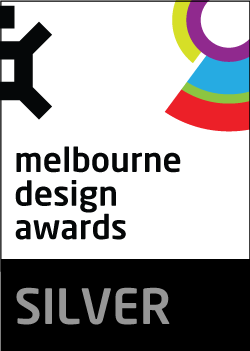








Image Credit : JACK LOVEL

Project Overview
This reinterpretation of a design tradition unique to Malaysia is counterpoised by the inspiration we take from modern dining concept such as that of Heston, his dish “sound of the sea” composes the audio experience of hearing the sound of the sea wave through sea shells and the olfactory experience of smelling the sea water, we aim to create an architectural journey that affect the senses in order to heighten the delight of the cuisine. We further developed the design from the contextual study of the modern Klang, one of the busiest oil plant site and port in Malaysia, we wish to translate the Klang's character in the design; Having timbers and steel into our material selection and at the same time reflects on the oceanic oil production which is also native to the Klang industry. The colour scheme of interior surface elements showcases a ocean oil refinery spectrum ranging from a vibrant yellow to that of a industrial metal grey, and great emphasis is given to a deep sea black that complies and complements our theme of the Klang contextual condition.
Project Commissioner
Project Creator
Team
NELSON LEE - MANAGING DIRECOR
KIET YEANG CHEW - PROJECT MANAGER
NICK HUYNH - DESIGN MANAGER
PHOEBE WONG - DESIGNER
JNT BUILDING & CO. - SHOPFITTER/BUILDER
Project Brief
The Klang & Co. conceptual design pivots around a desire to combine the tactility of the experience of dining with the contextual quality of Malaysia Klang Depot, which is the provenance of the restaurant culture. Our design deploys elements which invoke sensual responses and contextual association, the crane structure overhead adds visual potency to the dining environment, it reflects the industrial oil processing which is essential to Klang's economic boom, the artificial identity of the crane is counterpoised by the suspended tables, translucent screen wall which signify sea bubble and the sea; and level of bright glimpse effect throughout the spatial arrangement, embodied the illumination atmosphere of the Klang depot’s night life . Deliberately designed elements permeate the restaurant to embellish the overall setting just as sea lives dwell in the sea. The restaurant layout celebrates the coastal industrial process of on and offloading cargo containers, a parallel can be drawn with the on and offloading of pre-packaged food, just like modern craft no longer limits itself to handmade goods and is continuously expanding its possibilities through machine processing, the craftsmanship of takeaway food can inherit authenticity and quality without compromising the effectiveness of its distribution.
Project Innovation/Need
Working with the relatively small floor area, we have planned the layout carefully based on the customer flow and the business typology. The 1st section, "the food station" where we have highlighted it with the feature yellow framing; as it also forms the focal point of the shop and indirectly abstracting 'the crane craning cargo container'. For the high seats area, we have defined this area with reflective checker-plate flooring and wall cladding to express visual and tactile qualities of an industrial setting. The communal table seating area is back-dropped with an abstract illustration of stack-up cargo containers at Klang port; to further interpret the configuration of an industrial depot in a minimalism manner.
The ceiling and one side of the wall are painted in satin black to create a boundless optical impression to the shop, breaking the compacted spatial experience.
The fusion of rugged industrialism impression and the minimalist clean line design provokes an interior space that celebrates the urban Melbourne take away culture. The population of this area are mainly the younger generation, hence, high stools seating typology could physically translate the space into an informal setting that gives ease to the customers that come into the shop. Communal seating will also work as a social space where meeting new friend is accepted and even expected. We intended to highlight this congregation area as bring more excitement into dining atmosphere.
Design Challenge
Seeking the balance between the rugged industrialism and crisp clean minimalism became a challenge in this project. Structural elements are designed into feature elements, allowing the masculine silhouettes showcase in their barest essential state, proved to be quite challenging. The installation process also required careful planning due the size of the overhead framing. Structural concern, transportation method and installation procedure are extremely crucial during design and communication.
Taking this shop as the flagship store, understanding the business typology is significant to provide uninterrupted human flow in design. Linear arrangement of bain-marie and drink fridge on the left of the shop to provide customer's convenience during purchase, without interrupting into the seating areas.
The design is intended to create a lighting atmosphere in an oil plants where spotlights are used mainly in focusing the dock, plants and work pathways. Hence, the lighting was designed to be area focus.
Soft lighting was also created behind the partition screen adding a sense of mysterious to the space. Translating an industrial lighting atmosphere in to an urban setting proved to be out of norm and inspirational.
Sustainability
Sourcing local materials is one of our main approach in creating a sustainable design. It gives us the control over the materials to prevent any material wastage and avoid long distance transportation.
Low VOC paint & materials, low energy lights and plywood furniture also the sustainable elements that the design has incorporated. Due to the nature of the shop, it will be experiencing high human traffic at all time, therefore, the durability and level of maintenance of the materials are also part of the important criteria that we need to consider throughout the design.
Interior Design - Hospitality - On the Go
This award celebrates innovative and creative building interiors, with consideration given to space creation and planning, furnishings, finishes, aesthetic presentation and functionality. Consideration also given to space allocation, traffic flow, building services, lighting, fixtures, flooring, colours, furnishings and surface finishes.
More Details

